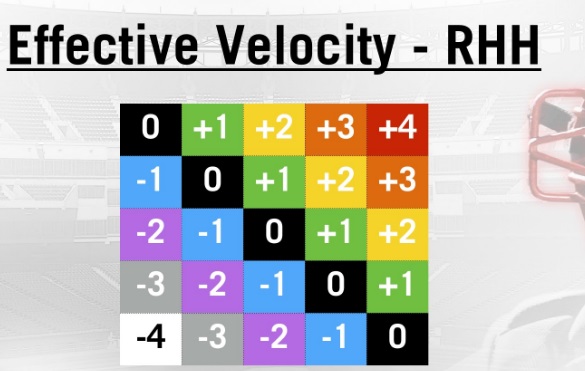(Photo by Nick Wosika/Icon Sportswire)
Craig Kimbrel of the Boston Red Sox is going to be my focus today in terms of how he was able to use (consciously or not) Effective Velocity to strike out New York Yankees outfielder Aaron Judge. If you’re not aware or familiar with EV, see my posts here and here to understand the concept created by Perry Husband.
When reading the EV of pitches, don’t think of it in terms of velocity but instead think of EvMPH as a measurement of timing for the hitter. If a pitch is thrown at 90 MPH but the location in the Ev zone ‘converts’ the velocity to 95 MPH, that means that the hitter has to time the 90 MPH pitch as though its a 95 MPH pitch. The principal foundation of EV is timing, which is everything to a hitter.
Kimbrel uses two very good pitches; a four-seam fastball that averages 98 MPH and a knuckle curve which averages 87 MPH. Judge will come to the plate with his mind’s eye prepared to time both pitches using those averages. The problem is the radar gun is fools gold and I’ll explain why.
Here is the EV chart to reference as the overlaid chart may be tough to read.

Image 1
Take a look at the five-pitch sequence during the Judge at-bat in the bottom of the ninth.
[gfycat data_id=”NaivePoshGuanaco”]
We have a middle-away four-seam fastball fouled off, a down and away curve for a ball, a down and in curve called a strike, another down and away curve for a ball, and middle-high four-seam fastball for a swinging strike. Looking at the radar gun readings we see 98MPH>88MPH>87MPH>87MPH>98MPH. All right in line with Kimbrel’s average and pretty much what Judge is expecting.
We read about a 10 MPH spread between both pitches; pretty good, right? Well, his EV sequencing and location is what makes that spread even better and that much more unfair.
Let’s look at the first pitch, the 98 MPH fastball that Judge fouled off.
[gfycat data_id=”EverlastingBlondBluefintuna”]
The fastball lands in the -1 MPH Ev zone, creating an EvMPH of 97. Just by looking at the swing, Judge is roughly 5-10 MPH late. Without an accurate side-view, its tough to approximate but you can guess by looking at his body language. At the pause, you can see that he took a decent cut but he’s reaching a little and sticking his butt out ever so slightly.
Pitch number two, an 88 MPH curveball.
[gfycat data_id=”HollowVengefulAmericankestrel”]
Obviously well outside the zone but Kimbrel creates a large EV spread; from 97 EvMPH to 82 EvMPH.
When you overlay pitch one and two, you see an example of Kimbrel using a pitch tunnel to attempt to throw Judge off. Once both pitches reach the point of recognition, they start to break off. Judge, being a great hitter, is able to recognize that pitch two (the curve) was moving well out of the zone so he lays off. Average hitters would not be so savvy; seeing both pitches moving through the tunnel, the hitter could make the mistake of assuming he’s going to get another four-seam fastball and not only miss badly, but because his mind’s eye is keyed to the previous pitch of 98 MPH, he would be way, way early on the pitch.
[gfycat data_id=”WearyRigidBeaver”]
On to pitch number three, an 87 MPH knuckle curve taken for a strike.
[gfycat data_id=”FineIllegalEnglishpointer”]
Judge takes the pitch which lands in the ‘null’ EV zone where there is no difference in actual to effective velocity. Due to location, we have a smaller Ev spread of +5 MPH (82 EvMPH – 87 EvMPH); dangerous, but it works out for Kimbrel because Judge takes the pitch.
Based on Judge’s first swing (at 97 EvMPH which I surmised he was maybe 5-10MPH late), if he had kept his timing he could have driven that pitch (87 EvMPH) a long way.
To further elaborate, have a look at the timing of Judge’s swing on pitch one overlaid on pitch three, on which I presumed Judge (had he offered at the pitch) would have made solid contact.
[gfycat data_id=”SeparateGorgeousJabiru”]
The red dot at the pause is the location of the curve. At that point, the pitch is floating inside the strike zone right where (had he timed it the same way) Judge could have made 90-100% solid contact. Its hard to see Judges’ bat on this overlay but the location is prime for a hard-hit ball off the barrel.
Moving on to pitch four, we see Kimbrel returning to low and away with another 87 MPH curve that Judge lays off of.
[gfycat data_id=”ThoseValidKakarikis”]
Kimbrel, based on where he’s located the pitch, creates an EV spread of 5 MPH (this time -5 EvMPH). Being outside the zone, Kimbrel is safe from the 50/50 solid contact pitfall that Mr. Husband discovered was within the risk zone (inside of +/- 6 EvMPH).
Finally, pitch five has Kimbrel dialing up his velocity with a 98 MPH four-seam fastball for the strikeout. Based on the Ev location, it’s actually closer to 101 MPH.
[gfycat data_id=”UnfinishedLikableAvians”]
Judge is late once again; hands are pulled in a bit to his chest. It would appear he timed this pitch the same way he tried to time the first one (87 EvMPH) except this time he completely misses.
In this sequence, Kimbrel spreads (velocity-wise) and varies his pitches really well. He places them in ideal locations to create the (velocity) difference while making it even larger when applying EV principles.
